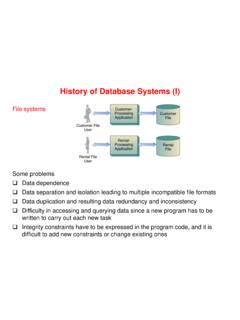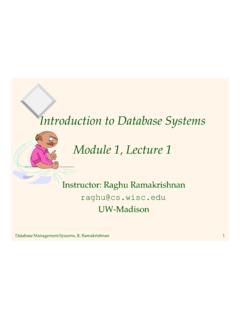Transcription of An Introduction to Spatial Database Systems
1 An Introduction to Spatial Database SystemsRalf Hartmut G tingPraktische Informatik IV, FernUniversit t HagenD-58084 Hagen, We propose a definition of a Spatial Database system as a Database system that offersspatial data types in its data model and query language and supports Spatial data types in its implemen-tation, providing at least Spatial indexing and Spatial join methods. Spatial Database Systems offer theunderlying Database technology for geographic information Systems and other applications.
2 Wesurvey data modeling, querying, data structures and algorithms, and system architecture for suchsystems. The emphasis is on describing known technology in a coherent manner rather than on listingopen Contribution to aSpecial Issue on Spatial Database Systemsof the VLDB Journal (Vol. 3, No. 4, October 1994)September 1994 1 1 What is a Spatial Database system ?In various fields there is a need to manage geometric, geographic, or Spatial data, which means datarelated to space. The space of interest can be, for example, the two-dimensional abstraction of (partsof) the surface of the earth that is, geographic space, the most prominent example , a man-madespace like the layout of a VLSI design, a volume containing a model of the human brain, or another3d-space representing the arrangement of chains of protein molecules.
3 At least since the advent ofrelational Database Systems there have been attempts to manage such data in Database for the technology emerging to address these needs is the capability to deal with largecollections of relatively simple geometric objects, for example, a set of 100 000 polygons. This issomewhat different from areas like CAD databases (solid modeling etc.) where geometric entities arecomposed hierarchically into complex structures, although the issues are certainly terms have been used for Database Systems offering such support like pictorial, image,geometric, geographic, or Spatial Database system .
4 The terms pictorial and image databasesystem arise from the fact that the data to be managed are often initially captured in the form of digitalraster images ( remote sensing by satellites, or computer tomography in medical applications).The term Spatial Database system has become popular during the last few years, to some extentthrough the series of conferences Symposium on Large Spatial Databases (SSD) held bi-annuallysince 1989 [Buch89, G nS91, AbO93], and is associated with a view of a Database as containing setsof objects in space rather than images or pictures of a space.
5 Indeed, the requirements and techniquesfor dealing with objects in space that have identity and well-defined extents, locations, and relation-ships are rather different from those for dealing with raster images. It has therefore been suggested toclearly distinguish two classes of Systems called Spatial Database Systems and image databasesystems, respectively [G nB90, Fra91]. Image Database Systems may include analysis techniques toextract objects in space from images, and offer some Spatial Database functionality, but are alsoprepared to store, manipulate and retrieve raster images as discrete entities.
6 In this survey we onlydiscuss Spatial Database Systems in the restricted sense. Several papers in this special issue addressimage Database problems and so complement the is a Spatial Database system ? We are not aware of a generally accepted definition. The followingreflects the author's personal view:(1)A Spatial Database system is a Database system .(2)It offers Spatial data types (SDTs) in its data model and query language.(3)It supports Spatial data types in its implementation, providing at least Spatial indexing andefficient algorithms for Spatial us briefly justify these requirements.
7 (1) sounds trivial, but emphasizes the fact that Spatial , orgeometric, information is in practice always connected with non- Spatial ( alphanumeric) cares about a special purpose system that is not able to handle all the standard data modelingand querying tasks. Hence a Spatial Database system is a full-fledged Database system with additionalcapabilities for handling Spatial data. (2) Spatial data types, POINT, LINE, REGION, provide afundamental abstraction for modeling the structure of geometric entities in space as well as their rela-tionships (l intersects r), properties (area(r) > 1000), and operations (intersection(l, r) the part ofl lying within r).
8 Which types are used may, of course, depend on a class of applications to besupported ( rectangles in VLSI design, surfaces and volumes in 3d). Without Spatial data types asystem does not offer adequate support in modeling. (3) A system must at least be able to retrieve 2 from a large collection of objects in some space those lying within a particular area without scanningthe whole set. Therefore Spatial indexing is mandatory. It should also support connecting objects fromdifferent classes through some Spatial relationship in a better way than by filtering the cartesianproduct (at least for those relationships that are important for the application).
9 The purpose of this survey is to present in a coherent way some of the fundamental problems andtheir solutions in Spatial Database Systems . The focus is on describing solutions that have been foundrather than on listing many open problems. We consider Spatial DBMS to provide the underlying data-base technology for geographic information Systems (GIS) and other applications. As such, they canoffer only some basic capabilities; it is not claimed that a Spatial DBMS is directly usable as anapplication-oriented the following four sections we consider modeling, querying, tools for implementation (datastructures and algorithms), and system architecture for Spatial Database needs to be represented?
10 The main application driving research in Spatial Database Systems are GIS. Hence we consider somemodeling needs in this area which are typical also for other applications. Examples are given for two-dimensional space, but almost everywhere, extension to the three- or more-dimensional case is pos-sible. There are two important alternative views of what needs to be represented:(i)Objects in space: We are interested in distinct entities arranged in space each of which hasits own geometric description.(ii)Space: We wish to describe space itself, that is, say something about every point in first view allows one to model, for example, cities, forests, or rivers.












